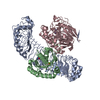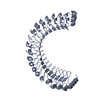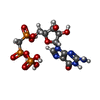+ Open data
Open data
- Basic information
Basic information
| Entry |  | |||||||||
|---|---|---|---|---|---|---|---|---|---|---|
| Title | Cryo-EM structure of the SHOC2:PP1C:MRAS complex | |||||||||
 Map data Map data | Final map | |||||||||
 Sample Sample |
| |||||||||
 Keywords Keywords |  Phosphatase / Phosphatase /  leucine rich repeat / RAF / leucine rich repeat / RAF /  complex / complex /  SIGNALING PROTEIN SIGNALING PROTEIN | |||||||||
| Function / homology |  Function and homology information Function and homology informationcellular response to growth hormone stimulus / protein phosphatase type 1 complex / negative regulation of neural precursor cell proliferation / PTW/PP1 phosphatase complex / regulation of nucleocytoplasmic transport / GTP-dependent protein binding / nerve growth factor signaling pathway /  protein phosphatase 1 binding / protein phosphatase regulator activity / protein phosphatase 1 binding / protein phosphatase regulator activity /  lamin binding ...cellular response to growth hormone stimulus / protein phosphatase type 1 complex / negative regulation of neural precursor cell proliferation / PTW/PP1 phosphatase complex / regulation of nucleocytoplasmic transport / GTP-dependent protein binding / nerve growth factor signaling pathway / lamin binding ...cellular response to growth hormone stimulus / protein phosphatase type 1 complex / negative regulation of neural precursor cell proliferation / PTW/PP1 phosphatase complex / regulation of nucleocytoplasmic transport / GTP-dependent protein binding / nerve growth factor signaling pathway /  protein phosphatase 1 binding / protein phosphatase regulator activity / protein phosphatase 1 binding / protein phosphatase regulator activity /  lamin binding / SHOC2 M1731 mutant abolishes MRAS complex function / Gain-of-function MRAS complexes activate RAF signaling / positive regulation of Ras protein signal transduction / lamin binding / SHOC2 M1731 mutant abolishes MRAS complex function / Gain-of-function MRAS complexes activate RAF signaling / positive regulation of Ras protein signal transduction /  microtubule organizing center / Maturation of hRSV A proteins / myosin phosphatase activity / microtubule organizing center / Maturation of hRSV A proteins / myosin phosphatase activity /  protein serine/threonine phosphatase activity / glycogen metabolic process / protein-serine/threonine phosphatase / Triglyceride catabolism / entrainment of circadian clock by photoperiod / protein serine/threonine phosphatase activity / glycogen metabolic process / protein-serine/threonine phosphatase / Triglyceride catabolism / entrainment of circadian clock by photoperiod /  phosphatase activity / phosphatase activity /  phosphoprotein phosphatase activity / phosphoprotein phosphatase activity /  cleavage furrow / blastocyst development / negative regulation of neuron differentiation / fibroblast growth factor receptor signaling pathway / Amplification of signal from unattached kinetochores via a MAD2 inhibitory signal / Mitotic Prometaphase / EML4 and NUDC in mitotic spindle formation / positive regulation of glial cell proliferation / Resolution of Sister Chromatid Cohesion / positive regulation of neuron differentiation / protein dephosphorylation / Downregulation of TGF-beta receptor signaling / cleavage furrow / blastocyst development / negative regulation of neuron differentiation / fibroblast growth factor receptor signaling pathway / Amplification of signal from unattached kinetochores via a MAD2 inhibitory signal / Mitotic Prometaphase / EML4 and NUDC in mitotic spindle formation / positive regulation of glial cell proliferation / Resolution of Sister Chromatid Cohesion / positive regulation of neuron differentiation / protein dephosphorylation / Downregulation of TGF-beta receptor signaling /  small monomeric GTPase / G protein activity / cellular response to leukemia inhibitory factor / RHO GTPases Activate Formins / RAF activation / circadian regulation of gene expression / neuron differentiation / small monomeric GTPase / G protein activity / cellular response to leukemia inhibitory factor / RHO GTPases Activate Formins / RAF activation / circadian regulation of gene expression / neuron differentiation /  regulation of circadian rhythm / regulation of circadian rhythm /  kinetochore / positive regulation of neuron projection development / Separation of Sister Chromatids / GDP binding / kinetochore / positive regulation of neuron projection development / Separation of Sister Chromatids / GDP binding /  MAPK cascade / MAPK cascade /  Circadian Clock / presynapse / midbody / actin cytoskeleton organization / Circadian Clock / presynapse / midbody / actin cytoskeleton organization /  spermatogenesis / spermatogenesis /  protein phosphatase binding / mitochondrial outer membrane / Ras protein signal transduction / protein phosphatase binding / mitochondrial outer membrane / Ras protein signal transduction /  dendritic spine / nuclear speck / dendritic spine / nuclear speck /  cell cycle / protein domain specific binding / cell cycle / protein domain specific binding /  cell division / cell division /  focal adhesion / focal adhesion /  GTPase activity / glutamatergic synapse / protein-containing complex binding / GTPase activity / glutamatergic synapse / protein-containing complex binding /  nucleolus / GTP binding / nucleolus / GTP binding /  protein kinase binding / protein kinase binding /  signal transduction / protein-containing complex / signal transduction / protein-containing complex /  mitochondrion / mitochondrion /  RNA binding / RNA binding /  nucleoplasm / nucleoplasm /  metal ion binding / metal ion binding /  nucleus / nucleus /  plasma membrane / plasma membrane /  cytosol / cytosol /  cytoplasm cytoplasmSimilarity search - Function | |||||||||
| Biological species |   Homo sapiens (human) Homo sapiens (human) | |||||||||
| Method |  single particle reconstruction / single particle reconstruction /  cryo EM / Resolution: 2.95 Å cryo EM / Resolution: 2.95 Å | |||||||||
 Authors Authors | Liau NPD / Johnson MC | |||||||||
| Funding support |  United States, 1 items United States, 1 items
| |||||||||
 Citation Citation |  Journal: Nature / Year: 2022 Journal: Nature / Year: 2022Title: Structural basis for SHOC2 modulation of RAS signalling. Authors: Nicholas P D Liau / Matthew C Johnson / Saeed Izadi / Luca Gerosa / Michal Hammel / John M Bruning / Timothy J Wendorff / Wilson Phung / Sarah G Hymowitz / Jawahar Sudhamsu /  Abstract: The RAS-RAF pathway is one of the most commonly dysregulated in human cancers. Despite decades of study, understanding of the molecular mechanisms underlying dimerization and activation of the kinase ...The RAS-RAF pathway is one of the most commonly dysregulated in human cancers. Despite decades of study, understanding of the molecular mechanisms underlying dimerization and activation of the kinase RAF remains limited. Recent structures of inactive RAF monomer and active RAF dimer bound to 14-3-3 have revealed the mechanisms by which 14-3-3 stabilizes both RAF conformations via specific phosphoserine residues. Prior to RAF dimerization, the protein phosphatase 1 catalytic subunit (PP1C) must dephosphorylate the N-terminal phosphoserine (NTpS) of RAF to relieve inhibition by 14-3-3, although PP1C in isolation lacks intrinsic substrate selectivity. SHOC2 is as an essential scaffolding protein that engages both PP1C and RAS to dephosphorylate RAF NTpS, but the structure of SHOC2 and the architecture of the presumptive SHOC2-PP1C-RAS complex remain unknown. Here we present a cryo-electron microscopy structure of the SHOC2-PP1C-MRAS complex to an overall resolution of 3 Å, revealing a tripartite molecular architecture in which a crescent-shaped SHOC2 acts as a cradle and brings together PP1C and MRAS. Our work demonstrates the GTP dependence of multiple RAS isoforms for complex formation, delineates the RAS-isoform preference for complex assembly, and uncovers how the SHOC2 scaffold and RAS collectively drive specificity of PP1C for RAF NTpS. Our data indicate that disease-relevant mutations affect complex assembly, reveal the simultaneous requirement of two RAS molecules for RAF activation, and establish rational avenues for discovery of new classes of inhibitors to target this pathway. | |||||||||
| History |
|
- Structure visualization
Structure visualization
| Supplemental images |
|---|
- Downloads & links
Downloads & links
-EMDB archive
| Map data |  emd_25044.map.gz emd_25044.map.gz | 32 MB |  EMDB map data format EMDB map data format | |
|---|---|---|---|---|
| Header (meta data) |  emd-25044-v30.xml emd-25044-v30.xml emd-25044.xml emd-25044.xml | 23.3 KB 23.3 KB | Display Display |  EMDB header EMDB header |
| FSC (resolution estimation) |  emd_25044_fsc.xml emd_25044_fsc.xml | 8.9 KB | Display |  FSC data file FSC data file |
| Images |  emd_25044.png emd_25044.png | 107.9 KB | ||
| Filedesc metadata |  emd-25044.cif.gz emd-25044.cif.gz | 6.8 KB | ||
| Others |  emd_25044_half_map_1.map.gz emd_25044_half_map_1.map.gz emd_25044_half_map_2.map.gz emd_25044_half_map_2.map.gz | 59.4 MB 59.4 MB | ||
| Archive directory |  http://ftp.pdbj.org/pub/emdb/structures/EMD-25044 http://ftp.pdbj.org/pub/emdb/structures/EMD-25044 ftp://ftp.pdbj.org/pub/emdb/structures/EMD-25044 ftp://ftp.pdbj.org/pub/emdb/structures/EMD-25044 | HTTPS FTP |
-Related structure data
| Related structure data |  7sd0MC  7sd1C M: atomic model generated by this map C: citing same article ( |
|---|---|
| Similar structure data | Similarity search - Function & homology  F&H Search F&H Search |
- Links
Links
| EMDB pages |  EMDB (EBI/PDBe) / EMDB (EBI/PDBe) /  EMDataResource EMDataResource |
|---|---|
| Related items in Molecule of the Month |
- Map
Map
| File |  Download / File: emd_25044.map.gz / Format: CCP4 / Size: 64 MB / Type: IMAGE STORED AS FLOATING POINT NUMBER (4 BYTES) Download / File: emd_25044.map.gz / Format: CCP4 / Size: 64 MB / Type: IMAGE STORED AS FLOATING POINT NUMBER (4 BYTES) | ||||||||||||||||||||
|---|---|---|---|---|---|---|---|---|---|---|---|---|---|---|---|---|---|---|---|---|---|
| Annotation | Final map | ||||||||||||||||||||
| Voxel size | X=Y=Z: 0.838 Å | ||||||||||||||||||||
| Density |
| ||||||||||||||||||||
| Symmetry | Space group: 1 | ||||||||||||||||||||
| Details | EMDB XML:
|
-Supplemental data
-Half map: Half map A
| File | emd_25044_half_map_1.map | ||||||||||||
|---|---|---|---|---|---|---|---|---|---|---|---|---|---|
| Annotation | Half map A | ||||||||||||
| Projections & Slices |
| ||||||||||||
| Density Histograms |
-Half map: Half map B
| File | emd_25044_half_map_2.map | ||||||||||||
|---|---|---|---|---|---|---|---|---|---|---|---|---|---|
| Annotation | Half map B | ||||||||||||
| Projections & Slices |
| ||||||||||||
| Density Histograms |
- Sample components
Sample components
+Entire : Ternary complex of SHOC2:PP1C:MRAS
+Supramolecule #1: Ternary complex of SHOC2:PP1C:MRAS
+Supramolecule #2: SHOC2
+Supramolecule #3: MRAS
+Supramolecule #4: PP1C
+Macromolecule #1: Leucine-rich repeat protein SHOC-2
+Macromolecule #2: Ras-related protein M-Ras
+Macromolecule #3: Serine/threonine-protein phosphatase PP1-gamma catalytic subunit
+Macromolecule #4: PHOSPHOMETHYLPHOSPHONIC ACID GUANYLATE ESTER
+Macromolecule #5: MAGNESIUM ION
+Macromolecule #6: MANGANESE (II) ION
-Experimental details
-Structure determination
| Method |  cryo EM cryo EM |
|---|---|
 Processing Processing |  single particle reconstruction single particle reconstruction |
| Aggregation state | particle |
- Sample preparation
Sample preparation
| Concentration | 0.19 mg/mL | |||||||||||||||||||||
|---|---|---|---|---|---|---|---|---|---|---|---|---|---|---|---|---|---|---|---|---|---|---|
| Buffer | pH: 7.5 Component:
| |||||||||||||||||||||
| Grid | Model: UltrAuFoil R1.2/1.3 / Material: GOLD / Support film - Material: GRAPHENE OXIDE / Pretreatment - Type: GLOW DISCHARGE / Pretreatment - Time: 20 sec. | |||||||||||||||||||||
| Vitrification | Cryogen name: ETHANE / Chamber humidity: 100 % / Chamber temperature: 277 K / Instrument: FEI VITROBOT MARK IV Details: Used the "perpetually hydrated" method of applying graphene oxide. (Cheung et al., 2018). |
- Electron microscopy
Electron microscopy
| Microscope | FEI TITAN KRIOS |
|---|---|
| Electron beam | Acceleration voltage: 300 kV / Electron source:  FIELD EMISSION GUN FIELD EMISSION GUN |
| Electron optics | Illumination mode: FLOOD BEAM / Imaging mode: BRIGHT FIELD Bright-field microscopy / Nominal defocus max: 1.5 µm / Nominal defocus min: 0.5 µm / Nominal magnification: 105000 Bright-field microscopy / Nominal defocus max: 1.5 µm / Nominal defocus min: 0.5 µm / Nominal magnification: 105000 |
| Sample stage | Cooling holder cryogen: NITROGEN |
| Image recording | Film or detector model: GATAN K3 (6k x 4k) / Number grids imaged: 1 / Average electron dose: 64.0 e/Å2 |
| Experimental equipment |  Model: Titan Krios / Image courtesy: FEI Company |
 Movie
Movie Controller
Controller
















 Z
Z Y
Y X
X























